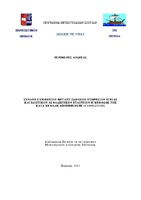Σύναψης συμφωνιών μεταξύ παρόχων υπηρεσιών υγείας και ιδιωτικών ασφαλιστικών εταιρειών: η μέθοδος της κατά κεφαλή αποζημίωσης (capitation).
Contracting between health services providers and private insurance companies: the capitation reimbursement method.

View/
Abstract
The purpose of this study is to assess the relationship between health provider and private insurance company, which consists of cash flows from the insurance company to the provider and flow of health services from the provider to the customers of the insurance company. This exchange of services and cash flows are recorded and become the subject of agreement between these parties. Given the need to reduce the ever-increasing healthcare costs, promoting prepaid insurance programs is considered a unique solution. The individual characteristics of the method of per capita compensation and its integration in the relationship provider and insurer, reversing the terms of the assumption of financial risk are described in detail, emphasizing on imprinting the conditions of proper operation of insurance programs under capitation reimbursement in their contracts. Furthermore, there is a description of the impact on health status of the population under the current crisis, and the results of the use of health services and the adaptation of the involved (provider, insurance company), affecting respectively the content of contracts. Furthermore, the need to use capitation reimbursement method becomes more imperative as a means to control and reduce the increasing costs that creates excess demand in the context of increased morbidity because of the hard circumstances we are experiencing. In the context of adaptation to current data, and maintaining the profitability of the operation of insurance programs under capitation reimbursement model, the determination of the remuneration of the provider, is the most intractable problem for the provider. Unknown factors, such as rate of use of health services, health status of the insurance portfolio in combination with other factors, such as age, environment work and residence must be counted in determining the remuneration of the provider.


